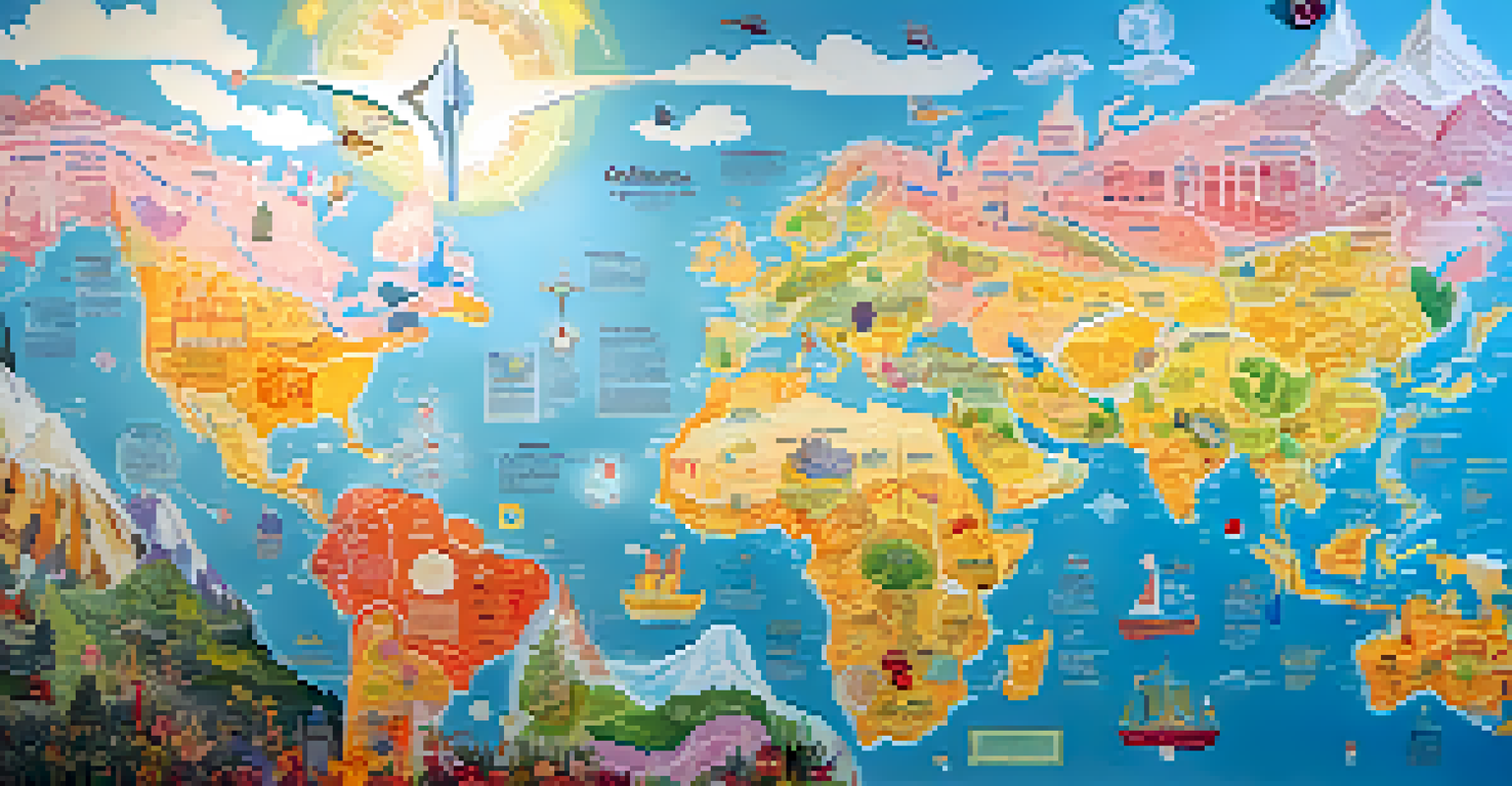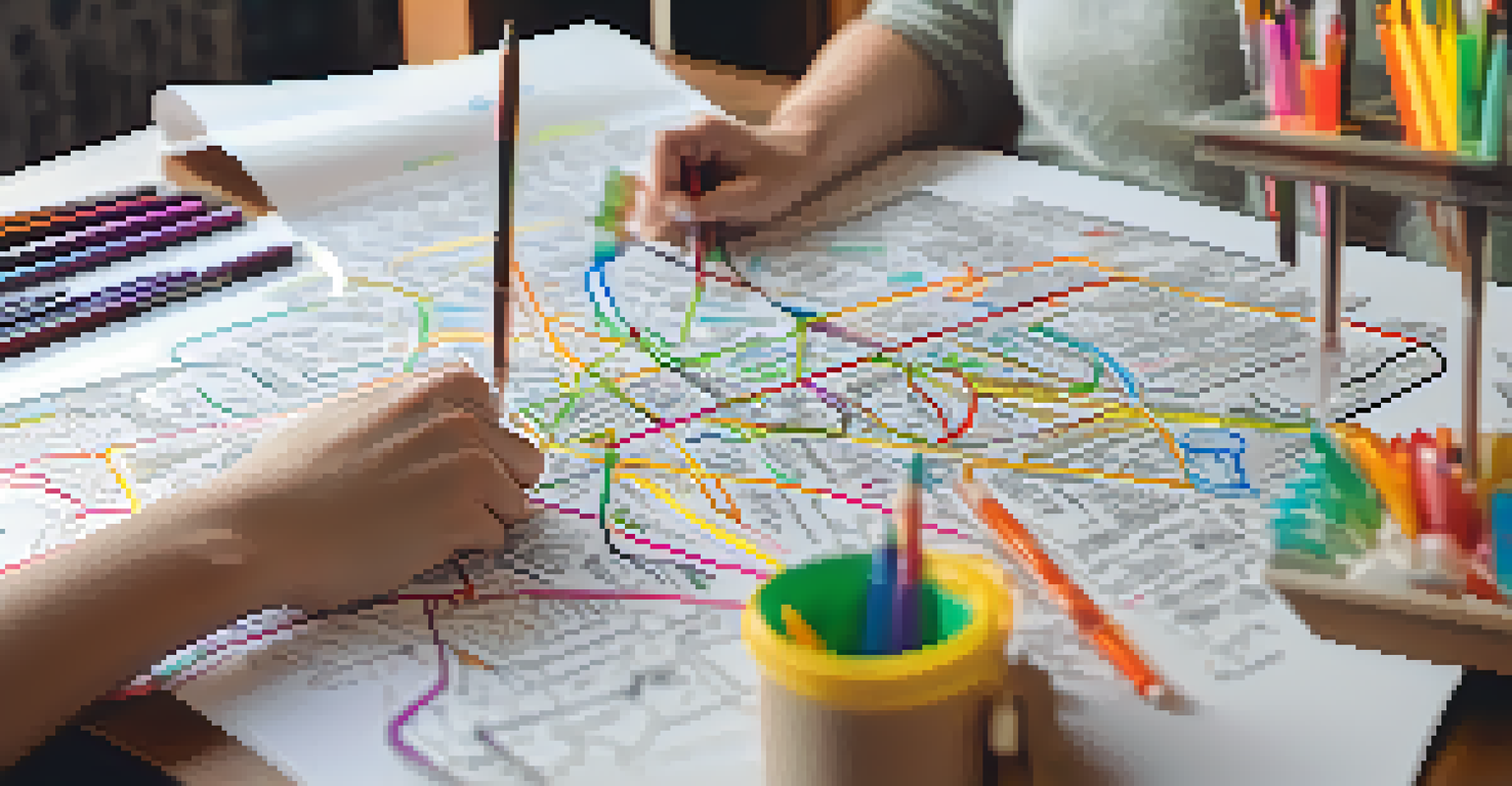Creating Your Life Map: Step-by-Step Process Explained

Understanding the Concept of a Life Map
A life map is a visual representation of your journey, encompassing your past, present, and future. Imagine it as a personal roadmap that helps you navigate your life's choices and aspirations. By putting your thoughts and dreams on paper, you can gain clarity about where you’ve been and where you want to go.
The journey of a thousand miles begins with one step.
Life mapping encourages self-reflection, allowing you to identify significant events, achievements, and turning points that have shaped who you are today. Think of it as a storybook of your life, where each chapter reveals lessons learned and insights gained. This process can be both revealing and empowering, shedding light on your unique path.
Ultimately, creating a life map is about connecting the dots of your experiences and aspirations. It serves as a guide, providing direction when you feel lost or overwhelmed. Instead of wandering aimlessly, you can draw on your life map to remind you of your purpose and goals.
Gathering Your Materials for Life Mapping
Before diving into the creation of your life map, it's essential to gather the right materials. You might prefer using a large sheet of paper, a whiteboard, or even digital tools like mind-mapping software or apps. Whatever you choose, ensure it’s a medium where you feel comfortable expressing your thoughts creatively.

Consider having colored pens, markers, or sticky notes on hand. These tools can help differentiate various life stages, themes, or emotions associated with different experiences. For instance, you could use blue for challenges and green for achievements, making your life map visually appealing and easier to interpret.
Create Your Personal Life Map
A life map visually represents your journey, helping you navigate past experiences, present goals, and future aspirations.
Finally, set aside a quiet space and time free from distractions. The process of creating your life map requires focus and introspection, so create an environment where you can think deeply about your journey. This space will be your sanctuary for self-discovery, allowing you to immerse yourself in reflection.
Reflecting on Your Past: Key Experiences
To start crafting your life map, reflect on significant events in your past. Think about moments that have shaped your identity, such as educational milestones, family dynamics, or pivotal career choices. Write these events down chronologically to see how they connect to each other.
Life is what happens when you're busy making other plans.
As you jot down these key experiences, don’t forget to include both positive and negative moments. Each experience contributes to your growth and understanding of yourself. For example, a setback might have taught you resilience, while a success could have boosted your confidence.
This reflection is not about dwelling on the past but rather understanding how it has influenced your present. By acknowledging your journey, you can better appreciate your personal evolution and prepare for the future you want to create.
Mapping Out Your Present: Current Goals and Values
Next, focus on your present situation by identifying your current goals and values. What drives you? What are you passionate about? This step is crucial as it helps you understand what matters most to you right now. Consider writing down your core values, such as family, career, health, or creativity.
Visualize your current life stage and the various roles you play, like being a friend, parent, or professional. This can help you see where you might want to invest more time and energy. For instance, if you value relationships but haven’t been spending enough time with loved ones, this is a good opportunity to reassess your priorities.
Reflect on Past and Present
Reflecting on significant experiences and current values provides clarity and insight into your personal evolution.
By mapping out your present, you gain insight into how your current circumstances align with your values. This clarity will serve as a foundation for the next stage of your life map, where you’ll envision your future aspirations.
Envisioning Your Future: Dreams and Aspirations
Now that you have a clear picture of your past and present, it’s time to dream big about your future. What do you envision for yourself in the next five, ten, or even twenty years? Think about your ideal career, personal life, and achievements. Write these dreams down as they represent your aspirations.
Consider using techniques like visualization or vision boards to help articulate your dreams. This could involve cutting out images from magazines or finding quotes that resonate with your goals. The more vivid your vision, the more motivated you will be to work toward making it a reality.
Remember, your future aspirations can evolve over time, and that's perfectly okay. The key is to keep this section of your life map dynamic, allowing room for growth and change as you gain new experiences and insights.
Connecting the Dots: Creating Your Life Map
With all your reflections in place, it’s time to bring your life map to life. Start by drawing a timeline that includes your past experiences, present goals, and future aspirations. Use arrows, branches, or sections to illustrate how these elements connect and influence each other.
As you create your life map, don’t hesitate to incorporate symbols, images, or colors that resonate with you. This visual aspect not only makes your map more engaging but also helps you remember the emotions tied to each part of your journey. For instance, a sun symbol might represent optimism in your future.
Regularly Update Your Map
Your life map should evolve with you, requiring periodic reviews to celebrate milestones and adjust goals as needed.
The final product should be a unique representation of your life journey, insights, and aspirations. Hang it somewhere visible to remind yourself of your path and keep you motivated as you navigate life’s twists and turns.
Reviewing and Updating Your Life Map Regularly
Creating a life map isn’t a one-time event; it’s a living document that should evolve with you. Set aside time periodically—perhaps annually or biannually—to review and update your map. This practice allows you to reflect on your progress and make adjustments based on new experiences or changing goals.
During your reviews, celebrate the milestones you’ve achieved and reassess any goals that no longer serve you. Life is fluid, and it’s essential to remain adaptable. For example, you might find that a career goal you once cherished has shifted towards personal development instead.

By regularly revisiting your life map, you reinforce your commitment to your journey and ensure you stay aligned with your true self. This ongoing process fosters growth and personal development, empowering you to navigate life with purpose and clarity.